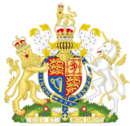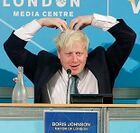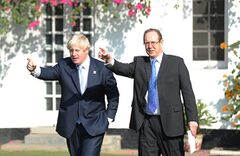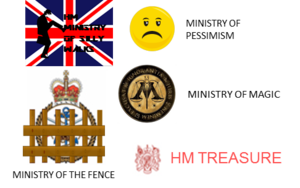Ministries of the UK Government
The Ministries of the UK Government are the government's individual departments. Each one is run by a minister, who gets a seat on the cabinet in 10 Downing Street (not the trophy cabinet; that is reserved for the Prime Minister).
The ministers are either power-hungry traitors to the party who will do anything to topple the Prime Minister, or they are the Prime Minister's puppets; underneath the Prime Minister's seat are pedals that control their mouths. Thousands of civil servants are employed by each ministry. However, the government hasn't figured out what they do, and largely ignore them.
The ministry buildings
| Part of a series on |
| Politics of the United Kingdom |
|---|
 |
| Government |
| Monarchy |
| Parliament |
| Leaders |
| Elections |
| Parties |
|
|
The ministry buildings are all situated on Whitehall Street in London, next to the river Thames — but not near enough to contaminate the drinking water. The routes from the ministry to the ministers' houses have strict restrictions to keep "plebs" from using them.
Inside the ministries is a bland interior with pristine, blank walls to inspire the ministers to create policies. Portraits of British people doing well are hung on the walls next to pictures of degraded post offices and naval ships being sent to the scrap yard. This makes the ministers think that the whole country is doing well and yet the government barely takes in any tax money, which inevitably leads the ministers to raise taxes, raise university fees, and employ Nick Clegg.
Ministries
There are only five actual ministries in the UK Government (and one High Ministry), thanks to recent government cuts. These ministries hold up the six pillars of the UK state, including the sixth pillar, Pub-culture.
The Ministry of The Fence
Often misspelt Ministry of Defence and therefore abbreviated to MOD, the Ministry of The Fence is in charge of the huge fence that surrounds the United Kingdom and keeps invaders out. The department is constantly modernising the Armed Forces that work under the Ministry of The Fence to prepare them for battle. New tanks that are being made now are up-to-date and instead of being equipped to face a World War threat they are used against illegal immigrants, a very real threat of invasion for the British Isles, with plows on the front to knock the immigrants down.
The Minister of The Fence is usually someone with experience of building garden furniture and who knows some basic Year 5 maths and can work out the perimeter of a rectangle. Famous Ministers of The Fence have been Winston Churchill, Pitt the Elder, Pitt the Younger, Pitt the Embryo and Margaret Thatcher who unofficially was the Minister for every ministry in the government at the same time as being Prime Minister and was the only real person on her cabinet. The rest of the politicians round the table were puppets on strings.
The Ministry's budget had been cut dramatically after the Second World War. At that time, the Norman and Viking invasion threat was brought down to "Medium Level" instead of "High Level" for the first time in one thousand years since Willy the Conker founded the Ministry of The Fence - as the fence was a key component in his mott and bailey castles. However when the Germans managed to punch through the Berlin Wall in 1989, the Government decided that a fence wasn't going to be strong enough to stop invaders and increased the Ministry of The Fence's spending budget in order to pay for the large extension that had been planned for Hadrian's Wall so that it surrounds the whole of Britain. Unfortunately Scotland was left out of that defence wall despite the fact that the Falkland Islands were squeezed in but the Scots didn't care anyway, as it helped them in their campaign for Scottish "FREEDOM!"
The Ministry of Silly Walks
Main article Ministry of Silly Walks

The Ministry of Silly Walks is the longest standing ministry in the UK Government. It was first said to be founded by King Arthur Pendragon himself and the Minister took one of the positions on his round table under the name of Sir Notappearinginthisfilm however there is no conclusive evidence of this and in popular belief the ministry was said to be founded by Sir Montgomery Python in 1811. The Germans tried to create their own Ministry of Silly Walks in 1933 under the name Die Ministrie dund Sillein Walke and it was run by Herr Goebelring Kesseldunstrope, however the Goosestep was hailed as a poor representation of traditional British Silly Walking (otherwise known as Maypole dancing).
The purpose of the ministry is to come up with walks that are so silly, that every time the politicians lie to the public and walk like this, the public thinks that they are joking and not lying. Tony Blair was a great campaigner for the invention of new silly walks precisely because of this reason. George Bush and he would practice silly walks every time before they went out and made a speech together.
The Ministry of Magic
The Ministry of Magic's purpose is to provide a connection between the Magic World and the Muggle World. The Minister of Magic is the only minister in the cabinet who is not a muggle and is in fact a witch or a wizard. The Ministry of Magic gets a lot of bad press from muggle media as some papers (such as The Daily Mail, which claims that the Ministry of Magic is part of the Grand Conspiracy) and even the Magic people themselves, as the ministry often lets "he who must not be named" take over the ministry and almost destroy the whole world, gives too many jobs to Eastern European immigrant wizards and witches, whilst increasing the unemployment rate amongst the hard-working British ones.
The Ministry of Magic can also help the Muggle World when it is experiencing a national disaster such as Hitler invading in 1940. Also, when the Ministry of Magic attempts to use the most powerful magic ever, it can find a way to stop the financial recession and to curse all the bankers.
The Ministry of Pessimism

The Ministry of Pessimism was established in 1707 after the beginning of the Parliamentary Union between England and Scotland. That year, the ban on pessimism was lifted in England and Wales to accommodate the attitude of the Scots. To fill the civil service in the ministry, the government rounded up every roundhead Puritan, who had managed to survive the Civil War, and gave him a job there. Soon after, the Ministry disparaged Christmas as a silly invention of consumerist Americans and blamed the weather on the French, so everyone is convinced that nothing at all can be done to make the situation a little better. This attitude continues to this day.
The ministry also has direct control of the state media and uses the BBC to broadcast educational films about beating the French and Germans and how young people today don't work hard enough to create a pessimistic, hate-filled atmosphere. The ministry forces newspapers such as The Daily Torygraph to report that immigration is awful and that Europe is too happy for the country to be part of it.
The Ministry of Hidden Treasure
The Ministry of Hidden Treasure ensures that all the gold that the country owns is locked away safe-and-sound, and that every piece that has gone missing is found. The Minister in charge of it is called the "Chancellor of the Checkers." This is because he has nothing better to do all day than play checkers. He also bets on games of checkers, because any winnings could help the economy and be paid out as benefits. This Ministry was originally called the Ministry of Treasure. However, after one Chancellor of the Checkers, Gordon Brown, became a Prime Minister, so much of Britain's gold went missing that the current name seemed more fitting.
The Ministry is also in charge of protecting the Crown Jewels. In 2012, the fateful decision to spray an anti-corrosive agent (reportedly WD-40) onto the Crown Jewels to keep them from rusting was made. The Ministry defended this action as "necessary, as the Empress of India's Crown hadn't been worn in a long time, due to the fact she is no longer Empress of India. The Crown cannot wait forever for Her Majesty to reclaim her title."
The Ministry of Administrative Affairs
Despite its name, the Ministry of Administrative Affairs is not classed as a proper ministry but is the only ministry to receive "High Ministry" status. In a time of crisis this ministry administers the whole government, from the Ministry of Pessimism to her Majesty. Currently the ministry has only one branch, the British Place Names Board which deals with the important matters of sign-postage, that concern the state much more than the finance or industry.
The Ministry has no logo as it represents the ultimate force of the government and therefore is all around you. Its motto is "Bigus Brotheria attempts watchus howeveria isus failingia becausia Bigus Brotheria nous hasus moneia".
See Also
| Featured version: 21 October 2013 | |
| This article has been featured on the main page. — You can vote for or nominate your favourite articles at Uncyclopedia:VFH. | |

